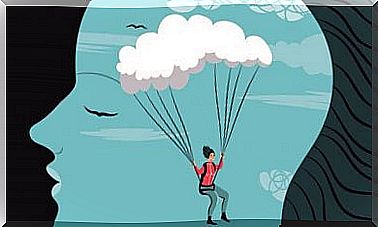Seligman’s Readiness Theory

Seligman’s theory of readiness explains how phobias are disproportionate reactions to harmless stimuli or stimuli that are not completely harmless but are controllable. There are countless theories about the emergence of phobias, and they are all partially correct. But what is the explanation for the fact that some phobias are more common than others?
Readiness theory explains that people are born ready to be afraid of certain types of stimuli more than others. Its two key concepts are readiness and propensity for the emergence of phobias. Today’s article explores them in more detail.
Readiness theory: general characteristics
Seligman developed his basic theory in response to the theory of potentiality, according to which all stimuli have the same chance of being treated. Against this, Seligman notes that people are phylogenetically willing to fear certain stimuli more than others.
This means that we are willing to deal with certain stimuli much more easily than others. This is an evolutionary process due to the need of organisms to adapt to their environment. Therefore, people are more likely to fear dangerous than harmless stimuli because they threaten human survival.

Properties of phobias
Seligman noted that phobias have these four characteristics:
- First, phobias occur in a particular area of stimuli because some situations arouse fear more easily than others. This selectivity seems to be related to the survival of the species.
- Phobias can arise easily and quickly.
- Resisting extinction is one of the hallmarks of phobias. It refers to resistance to the disappearance of conditional reactions to those stimuli that people generally consider immediately dangerous, compared to those that require multiple exposures.
- Irrationality. It is the lack of consonance or mismatch between the actual danger posed by the stimulus and the anxiety response.
Key concepts: preparation and tendency
Readiness refers to the evolutionary processes of a species. Therefore, there are three types of stimuli depending on how conditioned we are to them:
- Prepared stimuli are any stimuli that humans have biologically learned to be dangerous. In addition, this phobia can be triggered with a single exposure.
- Unmanufactured stimuli are those that people do not automatically learn to be dangerous and require multiple exposures.
- Newly prepared stimuli are ones that are impossible to learn as harmful despite continued exposure.
Similarly, susceptibility refers to the characteristics and ontogenetic development of an individual that make him or her more susceptible to phobias.
Extension of Öhman’s group priming theory
This group expanded the primer theory and distinguished phobias according to their phylogenetic or evolutionary source. It distinguishes between communicating and non-communicating fears.
Non-communicating fears are those that have no social or communicative function. Communicating fears, in turn, are those that have a social function to convey messages between species. In addition, there are animal- or interspecific phobias that are common in different species and social or intraspecific phobias among communicating fears.
Animal fears (interspecies) originate from a system of behavioral defense against predators and elicit avoidance or escape reactions triggered by automated processes. Thus, this response leads to high activation of the sympathetic autonomic nervous system.
In addition, social fears (intra-species) arise from domination-submission processes in the context of the same species. Therefore, they contain less automated, more reflexive processes and produce responses that depend on controlled processes. Therefore, they do not always produce sympathetic activation responses.

A great example of Seligman’s theory of readiness: the Garcia effect
This effect explains why people reject a particular food that caused them to get sick at some point. This conditional taste aversion occurs with a single exposure (easy to obtain). It is sufficient to maintain an avoidance response. In addition, people maintain it over time.
In their study, Garcia and Koelling found that not all stimulation of stimuli occurs with the same effort. For example, abdominal pain can be easily associated with a particular food or drink, but we would hardly associate it with a different stimulus, such as light or sound.
In addition to naming this discovery, Seligman personally experienced the Garcia effect. His experience showed that this connection between food and stomach upsets is so strong that not even reasoning can overcome this or any other phobias (namely, phobias are irrational).









